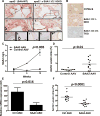Serum amyloid A3 is pro-atherogenic
- PMID: 29175652
- PMCID: PMC5839639
- DOI: 10.1016/j.atherosclerosis.2017.11.011
Serum amyloid A3 is pro-atherogenic
Abstract
Background and aims: Serum amyloid A (SAA) predicts cardiovascular events. Overexpression of SAA increases atherosclerosis development; however, deficiency of two of the murine acute phase isoforms, SAA1.1 and SAA2.1, has no effect on atherosclerosis. SAA3 is a pseudogene in humans, but is an expressed acute phase isoform in mice. The goal of this study was to determine if SAA3 affects atherosclerosis in mice.
Methods: ApoE-/- mice were used as the model for all studies. SAA3 was overexpressed by an adeno-associated virus or suppressed using an anti-sense oligonucleotide approach.
Results: Over-expression of SAA3 led to a 4-fold increase in atherosclerosis lesion area compared to control mice (p = 0.01). Suppression of SAA3 decreased atherosclerosis in mice genetically deficient in SAA1.1 and SAA2.1 (p < 0.0001).
Conclusions: SAA3 augments atherosclerosis in mice. Our results resolve a previous paradox in the literature and support extensive epidemiological data that SAA is pro-atherogenic.
Keywords: Atherosclerosis; Inflammation; Murine models.
Published by Elsevier B.V.
Conflict of interest statement
The authors declared they do not have anything to disclose regarding conflict of interest with respect to this manuscript.
Figures

References
-
- Johnson BD, Kip KE, Marroquin OC, et al. Serum amyloid A as a predictor of coronary artery disease and cardiovascular outcome in women: the National Heart, Lung, and Blood Institute-Sponsored Women's Ischemia Syndrome Evaluation (WISE) Circulation. 2004;109:726–732. - PubMed
-
- Ridker PM, Hennekens CH, Buring JE, et al. C-reactive protein and other markers of inflammation in the prediction of cardiovascular disease in women. N Engl J Med. 2000;342:836–843. - PubMed
-
- Furlaneto CJ, Campa A. A novel function of serum amyloid A: a potent stimulus for the release of tumor necrosis factor-alpha, interleukin-1beta, and interleukin-8 by human blood neutrophil. Biochem Biophys Res Commun. 2000;268:405–408. - PubMed
Publication types
MeSH terms
Substances
Grants and funding
LinkOut - more resources
Full Text Sources
Other Literature Sources
Medical
Molecular Biology Databases
Miscellaneous

